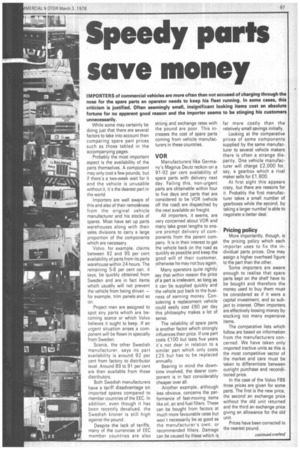Speedy parts save money
Page 99

If you've noticed an error in this article please click here to report it so we can fix it.
IMPORTERS of commercial vehicles are more often than not accused of charging through the nose for the spare parts an operator needs to keep his fleet running. In some cases, this criticism is justified. Often seemingly small, insignificant looking items cost an absolute fortune for no apparent good reason and the importer seems to be stinging his customers unnecessarily.
While some may certainly be doing just that there are several factors to take into account then comparing spare part prices such as those tabled in the accompanying pages.
Probably the most important aspect is the availability of the parts themselves. A component may only cost a few pounds, but if there's a two-week wait for it and the vehicle is unusable without it, it's the dearest part in the world.
Importers are well aware of this and also of their remoteness from the original vehicle manufacturer and his stocks of spares. Most have set up parts warehouses along with their sales divisions to carry a large proportion of the components which are necessary.
Volvo, for example, claims between 92 and 95 per cent availability of parts from its parts warehouse within 24 hours. The remaining 5-8 per cent can, it says, be quickly obtained from Sweden and are in fact items which usually will not prevent the vehicle from being driven — for example, trim panels and so on.
Project men are assigned to spot any parts which are becoming scarce or which Volvo believes it ought to keep. If an urgent situation arises a component will be flown in specially from Sweden.
Scania, the other Swedish manufacturer, says its part availability is around 92 per cent from factory to distributor level. Around 89 to 91 per cent are then available from these distributors.
Both Swedish manufacturers have a tariff disadvantage on imported spares compared to member countries of the EEC. In addition, even though it has been recently devalued, the Swedish kroner is still high against the pound.
Despite the lack of tariffs, many of the currencies of EEC member countries are also strong and exchange rates with the pound are poor. This increases the cost of spare parts coming from vehicle manufacturers in these countries
VOR
Manufacturers like Germany's Magirus Deutz reckon on a 91-92 per cent availability of spare parts with delivery next day. Failing this, non-urgent parts are obtainable within four to five days and parts that are considered to be VOR (vehicle off the road) are dispatched by the next available air freight.
All importers, it seems, are very concerned about VOR and many take great lengths to ensure prompt delivery of components from the parent company. It is in their interest to get the vehicle back on the road as quickly as possible and keep the good will of their customer, otherwise he may not buy again.
Many operators quite rightly say that within reason the price of a part is irrelevant, so long as it can be supplied quickly and the vehicle put back to the business of earning money. Considering a replacement vehicle could easily cost £60 per day this philosophy makes a lot of sense.
The reliability of spare parts is another factor which strongly influences their price. If one part costs £100 but lasts five years it's not dear in relation to a similar part which only costs £25 but has to be replaced annually.
Bearing in mind the downtime involved, the dearer component is in fact considerably cheaper over all.
Another example,although less obvious, concerns the performance of fast-moving items like oil, air and fuel filters. These can be bought from factors at much more favourable rates but won't necessarily be as good as the manufacturer's own, or recommended filters. Damage can be caused by these which is far more costly than the relatively small savings initially.
Looking at the comparative prices of some components supplied by the same manufacturer to several vehicle makers there is often a strange disparity. One vehicle manufacturer will charge £2,000 for, say, a gearbox which a rival maker sells for £1,800.
At first sight this appears crazy, but there are reasons for it. Probably the first manufacturer takes a small number of gearboxes while the second, by taking a larger number is able to negotiate a better deal:
Pricing policy
More importantly, though, is the pricing policy which each importer uses to fix the individual parts prices. One may assign a higher overhead figure to the part than the other.
Some importers are aware enough to realise that spare parts kept on the shelf have to be bought and therefore the money used to buy them must be considered as if it were a capital investment, and so subject to interest. Often importers are effectively loosing money by stocking too many expensive items.
The comparative lists which follow are based on information from the manufacturers concerned_ We have taken only imported tractive units as this is the most competitive sector of the market and care must be taken to differentiate between outright purchase and reconditioned price.
In the case of the Volvo F86 three prices are given for some parts. The first is the new price, the second an exchange price without the old unit returned and the third an exchange price giving an allowance for the old unit.
Prices have been corrected to the nearest pound.
































































































































































